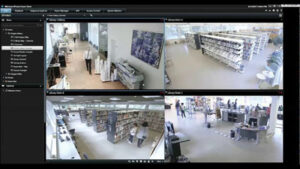There is no avoiding the fact that the security and surveillance sectors no longer exist in isolation when considering the technology-based footprint of businesses and organisations. Growth in the worlds of IoT, intelligent buildings and smart cities mean that an increasing number of end users are looking for more from their systems. Benchmark spoke exclusively to Bjørn Skou Eilertsen, CTO of Milestone Systems, to better understand his vision for the future.
Whilst many people like to herald the rise of new technological approaches such as smart cities, intelligent buildings and the Internet of Things as complex technological sea-changes that will either kill or cure the smart solutions sector, the concepts are actually quite simple. Indeed, rather than representing a brave new world, it could be argued that these options are simply a smart and much needed upgrade to established M2M (machine to machine) communications and the use of big data for intelligence gathering.
The core concept of the various approaches is the ability to connect devices, allowing them to share data in order to be more efficient and effective. Whilst the established and understood ‘internet’ is a network of computers and devices, predominantly with human operators, IoT and smart buildings bring automated intelligent devices into the mix.
IoT and smart building practices allow intelligent systems to make autonomous decisions based upon rules that have been programmed by the users, based upon data that has been shared by other connected devices.
In today’s world of mobile devices such as smartphones and tablets, wireless and data-based internet connectivity, apps and automation, a higher level of remote control can be exercised over a site’s systems by the end user. So, how might IoT and intelligent systems further impact on this scenario?
Bjørn Skou Eilertsen believes that video will be a key element of the advance of smarter solutions, but points out that many in other technological sectors have yet to realise the potential on offer. Indeed, at an IoT conference in London, attended by over 6,000 delegates, he was the only key note speaker to address the potential on offer from video.
‘It is interesting how the classic IoT companies, who are connecting many devices, are not thinking about cameras as IoT sensors,’ he states. ‘We’re in adjacent industries and video surveillance and IoT need to move together to get better connected. The way we see a lot of customers buying IoT management software or video management software is for different use-cases.
‘If you consider door panels or temperature sensors, they’re IoT devices, but all can work collectively with video management software via a Rules engine. Once people understand how we can combine the sensor information with video capabilities by using Rules engines, they will see how powerful it can be. It will often supercede the functionality that conventional IoT can deliver. That’s where I see the greatest opportunities for video solutions; to start creating a wider understanding of how customers can implement solutions.
‘If you consider applications such as car parks where traditionally they’ve installed video for security and surveillance purposes. They can now start tracking traffic flow, such as assessing how often visitors arrive and leave, the peak times of activity and other information which helps with business planning.
‘As far as I can see, a lot of integrators have far more competence and capability than they are aware of when it comes to delivering smarter solutions.’
Missed potential?
Bjørn Skou Eilertsen does recognise there is a danger that some people might miss the depth of functionality which is available from today’s smarter solutions, especially when considering the move towards delivering smarter systems.
 ‘I think there is a competence gap, a knowledge gap, about what systems are capable of doing, and we need to ensure integrators are aware of the possibilities. Maybe twenty per cent of integrators are very good at it, they make good profits and deliver flexible solutions. They have a small knowledge gap and understand what is possible.
‘I think there is a competence gap, a knowledge gap, about what systems are capable of doing, and we need to ensure integrators are aware of the possibilities. Maybe twenty per cent of integrators are very good at it, they make good profits and deliver flexible solutions. They have a small knowledge gap and understand what is possible.
‘From there, there is a widening knowledge gap which exists between the integrator and the end user. End users start demanding solutions which they think of as smart, but when they refer to smart, intelligent systems, it’s often little more than using one sensor to activate another device. That’s becoming more and more common. It’s simple and logical from a customer’s point of view, and that’s where the integrator needs to be careful. It’s not a conversation to be avoided because they haven’t designed systems like that before. Integrators need to engage customers and discuss automated scenarios where it’s not just about the video capabilities of the system, but a combination of sensors and inputs.
‘The Rules engine is going to be a key asset in such applications. It will allow business process optimisation based on combining video with IoT sensors.’
Bjørn Skou Eilertsen is also quick to acknowledge that today’s video-based solutions are often held back by public misconceptions about video surveillance, often harking back to the days of somewhat primitive and restricted technologies associated with CCTV. He believes that just as the technologies involved have evolved beyond all recognition, it is also critical that the way the systems are discussed changes too.
‘Refering to smart systems as CCTV will be a problem, because it refers to technology which is old-fashioned, and the limitations of old are frowned upon nowadays. Limiting thinking about video to surveillance and investigations highlights negative connotations. I prefer to talk about video’s role in enabling IoT. It’s a better way to position the technology, highlighting what it can do, rather than discussing video surveillance as an IoT element.
‘It is just vocabulary, but if you’re talking to customers who want video-enabled IoT and smart solutions which span beyond traditional surveillance and security purposes, it underlines the depth of use-cases which can be met.’
Service provision
There is a growing move in the smart solutions industry to stop considering how to sell systems, and to move to a more service-based provision model. An increasing number of end users are running core business functionalities based around services such as SaaS (software as a service) in their everyday working lives, and as such it could be a necessary step to meet user expectations and offer a wider range of video-enabled services.
 Bjørn Skou Eilertsen agrees, but is quick to stress the emphasis should be on services and not on the cloud.
Bjørn Skou Eilertsen agrees, but is quick to stress the emphasis should be on services and not on the cloud.
‘It’s going to require a mix of different services that collectively provide a solution for the customer. Some of these will be running on hardware in the local environment, while others will be off-site and remotely accessed.
‘If you look at what the OSSA (Open Security and Safety Alliance) is doing, the key focus is to standardise definitions of operating systems and devices, to create trust with customers concerning the deployment of IoT devices, and to allow shared capabilities while sitting on a common operating system and a common programming interface.
‘This should allow all devices to be managed in a coherent way, regardless of the manufacturer. The applications which will run on the devices will deliver seamless services and solutions. This will create a positive move away from the surveillance mentality where too many people believe the cloud is the answer to everything.’
Despite being an advocate of the OSSA approach, Bjørn Skou Eilertsen also recognises that the video industry cannot exist in an IoT world as a siloed entity, making its own rules and creating its own specifications via the new industry body. He accepts that the starting point is video surveillance, as it’s the current industry inhabited by the OSSA founders (Milestone, Bosch, Hanwha Techwin, Pelco and Vivotek), but in the future the scope will go beyond this into building automation, process control and a host of other industries.
He states, ‘Our industry, the video for surveillance purposes industry, needs to connect with the IoT industry. The reason we have to drive it is because if we wait for them to connect with us, we will have little or no control over what happens, and we may meet challenges over how the video will be used, dictated by people with little competence in video management. Therefore, it’s our obligation to reach out to the IoT industry, but doing it without a defined approach will be less credible than having a solid base to start with.’
A balanced approach
As a greater number of business efficiencies can be realised via video-enabled solutions, there is debate as to whether the focus for smart systems should be on added value. End users are more willing to invest in solutions which solve problems and deliver a tangible return on investment, and the security element – whilst remaining critical – might be less appealing when considering RoI.
 Bjørn Skou Eilertsen points out that since 1998, the Milestone Mission is the migration of analogue video to an IP platform, but it’s also about enabling customers and partners to drive operational efficiencies through the use of video.
Bjørn Skou Eilertsen points out that since 1998, the Milestone Mission is the migration of analogue video to an IP platform, but it’s also about enabling customers and partners to drive operational efficiencies through the use of video.
‘It’s taken a long time but it is starting happen, we are seeing the realisation of those efficiencies,’ he states. ‘What I would suggest is not to lead with the business efficiencies and leave the security surveillance part to the end. Now it might be too soon, maybe a little premature for the integrators who currently aren’t capable of speaking anything by security language, but it’s also maybe too soon to have the conversation with a customer.
‘What needs to happen is the security agenda must shift, and we can do a lot to make that happen. For example, instead of only having conversations with the head of security, we need to make the topic relevant for others in positions of leadership.
‘Disregarding the security element may make some integrators lose footing because if they try to compete with regular industrialised IoT, it might be a struggle. They’d be better off starting with a video surveillance agenda and expanding from there rather than leading with business optimisation, retail or factory automation, quality assurance of whatever.
‘The reason I’m saying that is not because the technology won’t do it. It’s because of the people around the technology. Would the majority of integrators be comfortable having a business efficiency conversation with their customer rather than having a security discussion?’
Despite this, Bjørn Skou Eilertsen recognises that many other sectors – IT, lighting, HVAC, communications, AV, etc. – have adapted to the demands for smart solutions faster than many in the security sector have, and admits there may be a need to seek new partnerships with those who are more at home with advanced solution provision.
‘The question is how fast we can educate the end users and other industries about the capabilities we offer, and how many of the current integrator market will be able to move ahead and take that leap.
‘I joined Milestone seven years ago and I’ve been startled by the slow movement of the end user perception. The channel model has always been based on the fact the integrator knows more than the end customer so the value has been in the ability to install and set up a surveillance system.
‘If you look at the IT industry, it used to be the same, but end users smartened up and started asking for solutions which were beyond what the IT integrators could provide. It necessitated a steep learning curve for the IT integration industry. It lead to a need for new integrators who were more versatile in the way they delivered solutions. Something similar will happen in the video market, and in the coming years it will be more difficult for traditional integrators to manage the expectations of their customers.
‘It will also be driven by adjacent industries which are more up to speed. Customers are asking for more integrated solutions that fulfil the needs of many use-cases, not just security.’
Adding value
Bjørn Skou Eilertsen recognises the importance of adding value to video-based systems. He states, ‘In order to build on what we offer today, we have to deliver data insights which add value. An example is to allow AI-enabled applications to run on top of the video management system. This enables the system to add benefits for any type of solution. There is much to be gained from providing business intelligence.’
The reality is clear: the future outlook for video is very good if we rise to meet the customers’ demands with smart solutions.
 Bjørn Skou Eilertsen is Chief Technology Officer, Milestone Systems. He joined Milestone in 2013, bringing a strong entrepreneurial background from the IT industry having fulfilled key roles at a series of start-ups, as well as product management, marketing and sales roles with both IBM and Microsoft. Prior to joining Milestone, he headed up the EMEA product management and sales operations for the Microsoft CRM business. He holds an MSc in Computer Science and Business Administration.
Bjørn Skou Eilertsen is Chief Technology Officer, Milestone Systems. He joined Milestone in 2013, bringing a strong entrepreneurial background from the IT industry having fulfilled key roles at a series of start-ups, as well as product management, marketing and sales roles with both IBM and Microsoft. Prior to joining Milestone, he headed up the EMEA product management and sales operations for the Microsoft CRM business. He holds an MSc in Computer Science and Business Administration.







